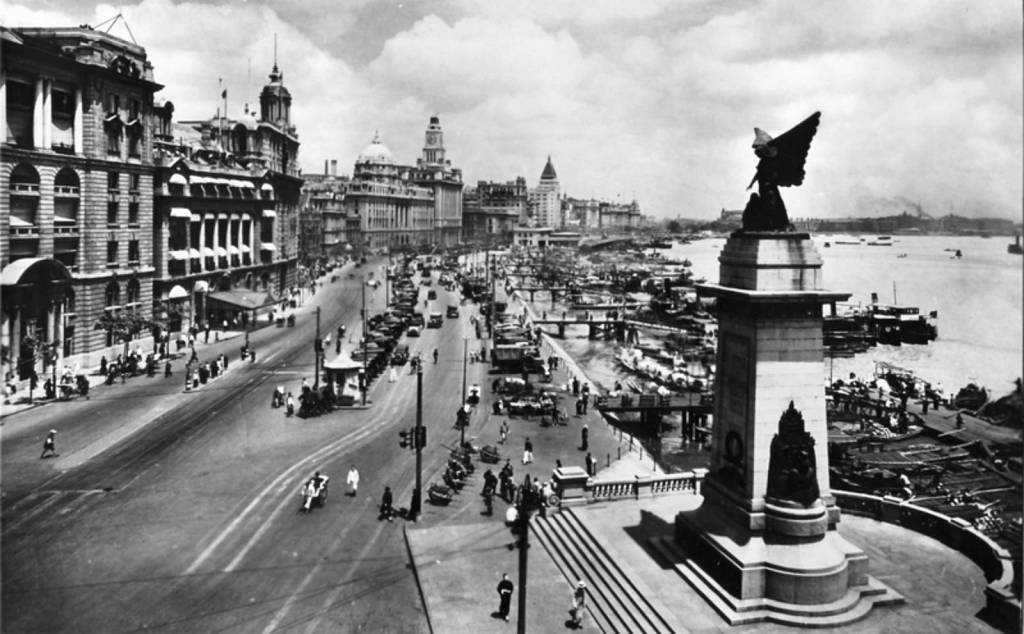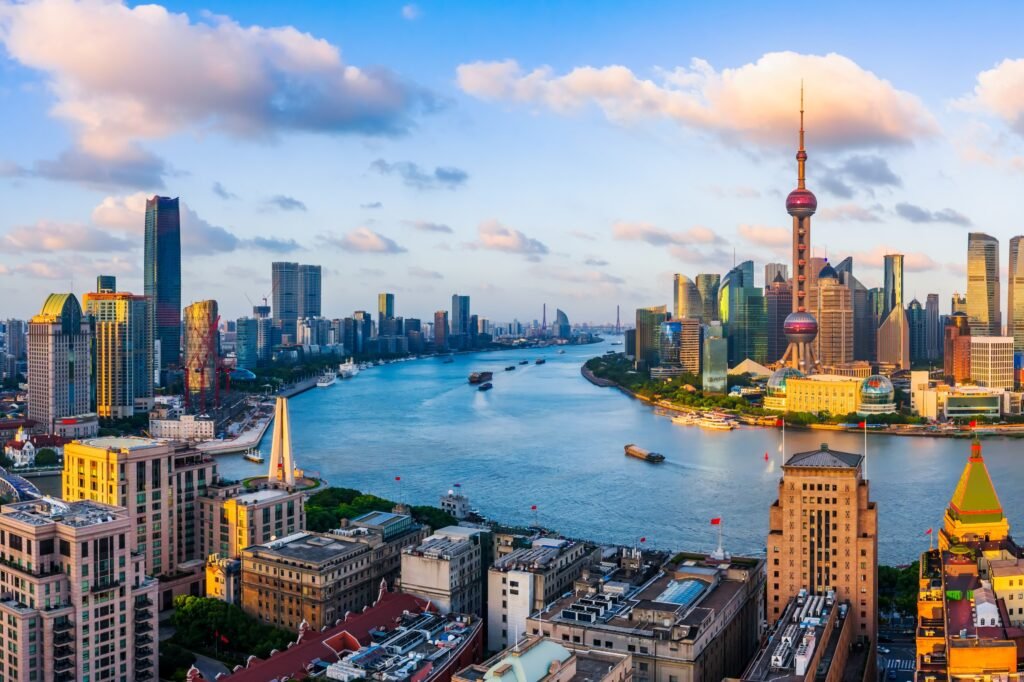Shanghai Then and Now
Shanghai Then
Shanghai, one of China’s largest and most dynamic cities, has a name that reflects its deep connection to the sea and its historical significance.
The characters in “Shanghai” translate to “On the Sea” or “Above the Sea.”
This name dates back to the Song dynasty in the 11th century, likely referring to the area’s strategic position by both river and ocean.
Some historians trace the city’s origins to over 2,000 years ago, beginning as a fishing village known as “Hu.” By 1280, it officially became “Shanghai.”
During the Tang dynasty, Shanghai’s low-lying coastal landscape made it appear as if it were situated directly on the sea, aligning with the meaning of its name.
This coastal proximity helped shape Shanghai’s role as a major port, industrial hub, and cultural center, establishing it as a city whose identity is closely tied to its maritime roots.

Shanghai History
Shanghai’s history is a fascinating journey from a small, undeveloped fishing village to one of the world’s most dynamic cities.
In the early centuries, from around the 5th to 7th centuries CE, the area—then known as Shen or Hudu—was sparsely populated and economically stagnant, largely due to its exposed delta location.
The southward expansion of Chinese settlement during this time brought slow but steady development, but it wasn’t until the Song dynasty (960–1126) that Shanghai began to show its future potential.
With a growing population and its advantageous position as a deepwater port, the city began to emerge as a shipping and trading hub, especially as inland and coastal shipping expanded.
Related Article: Singapore Then and Now
By the 11th century, Shanghai had established a customs office, and in the 13th century, it was designated a county seat under the administration of Jiangsu province, marking its rise in importance.
Under the Ming dynasty (1368–1644), Shanghai continued to grow as an agricultural and industrial center, particularly in cotton production, which supported the local textile industry.
By the 18th century, tens of thousands of workers were involved in cotton spinning.
However, Shanghai’s transformation accelerated dramatically in the mid-19th century when the city was forcibly opened to foreign trade after China’s defeat in the First Opium War (1839–42).
Related Article: Dubai Then and Now
The Treaty of Nanjing allowed foreign powers to establish concessions in the city, with Britain, France, and the United States quickly setting up exclusive zones where they enjoyed special privileges.
The influx of foreign businesses and the establishment of European banks and trading houses shifted Shanghai’s economy from agriculture to commerce, making it the center of Western commercial imperialism in China.
By the late 19th century, Shanghai had become China’s leading port, a critical gateway for trade due to its proximity to the Yangtze River and vast inland markets.
Industrialization began to take shape, with foreign capital establishing light industries in the foreign concessions.
Related Article: Singapore Then and Now

Chinese investment in industry remained limited until World War I, which temporarily reduced foreign competition, allowing local entrepreneurs a small foothold.
However, after the war, the return of Western and Japanese interests, compounded by the economic difficulties of the Great Depression, put severe pressure on Chinese businesses.
Foreign companies dominated the city’s economic landscape, and laborers were often drawn to the higher wages in foreign-owned factories.
The social and political climate of Shanghai was also evolving, especially in the 1920s, as the city became a focal point for political activism.
Related Article: Dubai Then and Now
Tensions from foreign control led to boycotts and protests, including the “May 30” Movement of 1925, an uprising against foreign imperialism and feudalism.
The Chinese Communist Party was founded in Shanghai in 1921, and the city became a center for revolutionary activity until the Nationalists suppressed the Communists in 1927.
Shanghai faced severe hardships during the Second Sino-Japanese War (1937–1945), enduring occupation, and extensive industrial damage.
After the war, Shanghai’s economy was further disrupted, and the city struggled until the People’s Liberation Army took control in 1949, marking the beginning of the Communist era.
Related Article: Hong Kong Then and Now
While the city initially saw limited growth due to national policies favoring internal regional development, by the 1960s, Shanghai resumed its role as a key center for scientific and technological advancement.
The late 20th century brought Shanghai’s most transformative period. The Chinese government, aiming to modernize and stimulate economic growth, invested heavily in Shanghai, with massive infrastructure projects, especially in the Pudong area.
The city became China’s financial and economic hub, with new skyscrapers defining its skyline and a modern transit system accommodating rapid population and traffic growth.
The 2010 World Expo was a crowning achievement, showcasing Shanghai’s development and solidifying its status as a global metropolis.
Today, Shanghai stands as a testament to resilience and reinvention, embodying both the cultural heritage and the economic aspirations of modern China.
Related Article: Tokyo Then and Now
Shanghai Now

Shanghai, China’s most populous city and a direct-administered municipality, serves as one of the country’s most important economic and cultural hubs.
Located at the mouth of the Yangtze River, Shanghai occupies a strategic position along China’s eastern coastline, with the Huangpu River flowing through the city center.
Its location has been crucial to its growth as a major center for commerce and transportation.
In 2023, Shanghai’s population within the city proper was around 24.87 million, making it the third-largest city in the world by population.
Related Article: Seoul Then and Now
Its urban area, housing approximately 29.87 million residents, is the most populous in China.
This immense population density reflects Shanghai’s dynamic urban life and high demand for economic opportunities.
As of 2022, the Greater Shanghai metropolitan area boasted a gross metropolitan product of nearly 13 trillion RMB ($1.9 trillion), underscoring its status as an economic powerhouse.
Shanghai is globally recognized as a center for finance, business, and economics, consistently ranking as one of the world’s top financial hubs.
Its influence extends across multiple sectors, including research, science and technology, manufacturing, and tourism.
Related Article: Bangkok Then and Now
As a leading city in scientific and technological innovation, Shanghai is at the forefront of China’s push towards a knowledge-based economy.
The city is also home to the Port of Shanghai, the world’s busiest container port, making it a central point in international shipping and logistics.
Additionally, Shanghai’s cultural and historical significance is profound. It has grown into a vibrant metropolis that blends traditional Chinese heritage with modern architectural wonders, making it a magnet for tourists.
With its advanced infrastructure and status as a global city, Shanghai plays an essential role in connecting China to the rest of the world, both economically and culturally.
Related Article: Kuala Lumpur Then and Now
FAQs
Shanghai is sometimes called “Demon City” because of its historical reputation for the opium trade, crime, and nightlife during the early 20th century.
This nickname emerged as foreigners poured into the city, bringing both prosperity and darker elements like gambling and organized crime, giving Shanghai an aura of mystery and intrigue.
Shanghai is best known for its role as a global financial hub, its iconic skyline along the Bund, its bustling port, and its vibrant mix of modern and traditional Chinese culture.
It’s also famous for shopping, cuisine, and historical landmarks, such as the Yuyuan Garden and the French Concession.
Shanghai is one of the most expensive cities in China, especially for housing, dining out, and entertainment.
However, more affordable options can be found for public transport, street food, and some everyday goods, making it possible to live within a range of budgets.
China lost control of parts of Shanghai to foreign powers following the Treaty of Nanjing in 1842, after the First Opium War.
This opened the city to foreign trade and led to the establishment of international concessions where foreign powers exercised their own laws and administration.






























